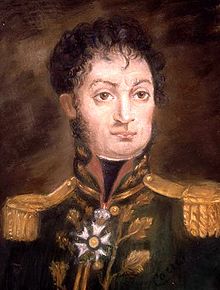Pierre Cambronne
Pierre Jacques Étienne Cambronne , later Pierre, vicomte Cambronne (born December 26, 1770 in Saint-Sébastien-sur-Loire (today Loire-Atlantique ); † January 29, 1842 in Nantes ) was a French Général de division in the time of First Empire .
Military career
Cambronne volunteered for the grenadiers in 1792 , served under Dumouriez in Belgium and the Vendée , took part in the Battle of Quiberon and then in the expedition to Ireland under General Hoche in 1796. He then served in the Alpine Army under the command of Masséna , where he excelled at the head of a grenadier company in the battle of Zurich (1799).
In 1800 he commanded the company in which Latour d'Auvergne served, and received the title of "First Grenadier of France" after this.
In Jena to Colonel promoted, he was commander of the 1810 third Voltigeurregiments the Imperial Guard and was in the same year Baron . He fought in Spain and was then sent back to the Grande Armée . During Napoléon's Russian campaign in 1812, he commanded the third voltigeur regiment of the Guard and took part in the Battle of Bautzen , Battle of Dresden and Battle of the Nations near Leipzig , before being promoted to Général de brigade after the Battle of Hanau .
The Hundred Days and Waterloo
He remained loyal to the emperor and was military commander of the island of Elba from 1814–1815.
During the Hundred Days he led the vanguard. He took the fortress of Sisteron (March 5th). When he arrived in Paris, Napoleon appointed him Comte . During the Battle of Waterloo he was in command of the 1st Guards Jäger Regiment on foot for the Old Guard and commanded the last square there . After being asked to surrender by the British General Colville , he is said to have replied:
«La Garde meurt mais ne se rend pas. »
"The guard dies, but they do not surrender."
The Englishman's penetrance led him to a much more energetic answer:
«Merde! »
"Crap!"
But he denied his whole life to have made this statement. The sources are also divided. So called Meyers Encyclopedia the verdict as "patriotic invention".
Nonetheless, his answer aroused far greater admiration among the English, who did everything to get him alive. The Scottish Lieutenant Colonel Hew or Hugh Halkett , commander of the 3rd Hanover Brigade, assured that he was responsible for this capture when Cambronne "went for a walk" in front of the square.
In French, in analogy to the German expression “ Götz-Zitat ”, the paraphrase “le mot de Cambronne” has been used since then.
End of military career
He was released to attend his treason trial in France. Defended by the royalist Pierre-Antoine Berryer , he was acquitted on April 26, 1816.
In 1820 Louis XVIII appointed him . to the Maréchal de camp , the commander of the fortress of Lille and the Viscount . In 1824 he retired to his native city before he died in Nantes.
Honors
His name is entered on the triumphal arch in Paris in the 8th column. The Parisian metro station Cambronne was named after him.
literature
- Hervé Le Boterf: Le brave général Cambronne . Paris, Éditions France-Empire 1984, ISBN 2-7048-0360-9
- Léon Brunschvicg : Cambronne; see vie civile, politique et militaire, ecrite d'apres les documents inedits des archives nationales et des archives du Ministere de la guerre . 1896
Web links
Individual evidence
- ↑ Cambronne, Pierre Jacques Étienne, 1770–1842 . In: Meyers Großes Konversations-Lexikon . 6th edition. Volume 3, Bibliographisches Institut, Leipzig / Vienna 1905, p. 716 .
- ↑ The Guard dies, but they do not surrender . In: The Gazebo . Issue 39, 1855, pp. 521 ( full text [ Wikisource ]).
| personal data | |
|---|---|
| SURNAME | Cambronne, Pierre |
| ALTERNATIVE NAMES | Cambronne, Pierre Jacques Étienne (full name) |
| BRIEF DESCRIPTION | French general during the Empire |
| DATE OF BIRTH | December 26, 1770 |
| PLACE OF BIRTH | Saint-Sébastien-sur-Loire |
| DATE OF DEATH | January 29, 1842 |
| Place of death | Nantes |
